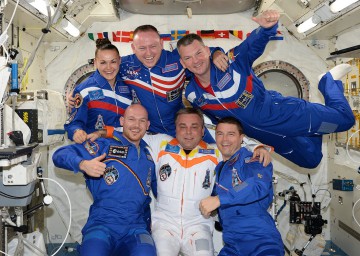
SPACE STATION WEEKLY UPDATE Nov. 3 – Nov. 9, 2014 — As astronauts Reid Wiseman, Alexander Gerst, and cosmonaut Max Suraev were preparing for their departure from the International Space Station (ISS) this week, business as usual still carried on. This week’s ISS activity update includes further experimentation on zebrafish muscle apathy, data cable replacement on the DEvice for the study of Critical LIquids and Crystallization – High Temperature Insert-Reflight (DECLIC HTI-R), relocation of the Special Purpose Inexpensive Satellite (SpinSat), and various routine human research studies, according to Vic Cooley, Lead Increment Specialist for Expedition 41/42.
European Space Agency (ESA) astronaut Alexander Gerst carried out maintenance on the aquatic habitat aboard the space station, which holds the subjects of the Zebrafish Muscle experiment, changing their water and getting the fish ready for their trip back to Earth with Expedition 41 aboard Soyuz TMA-13M later tonight. The fish have been raised on the ISS to examine the effects of microgravity and to show the effects that reintroduction of gravity has on the body’s musculature after returning from spaceflight.

To maintain muscle mass and strength during trips into space, physical movement and controlling one’s posture is essential. In microgravity, the body no longer requires use of the postural muscles (also known as the anti-gravity muscles), which, in turn, causes them to atrophy. The Japanese Aerospace Exploration Agency’s (JAXA) Zebrafish Muscle experiment examines this effect on the muscles of zebrafish in microgravity to answer if and why this happens. It will also determine how the muscles recover after the fish return to Earth and the force of gravity, and if the effects are similar to the changes that occur on the muscles after exercise.
The molecular changes that may be causing muscle atrophy in microgravity are what the scientists wish to determine from the investigation. Patients who are placed on bed rest and people with limits to their mobility could benefit from the new drugs or treatments that might come into existence due to the grasp on how chemical signals, proteins, and cellular activity that plays a part in the decrease in the function of muscles as a result of this research. In addition, it will help us gain knowledge about how the loss of muscle in astronauts on long-duration missions can be prevented.
Gerst also completed work moving the SpinSat experiment to a new location on the station, where it will stay until it is deployed. Previously located in the Japanese Experiment Module, it now resides in Node 2. SpinSat is 22 inches in diameter, spherically shaped, and it houses a variety of solid propellant thrusters, which are controlled electrically. With a mass of approximately 50 kg, the satellite has a single axis momentum wheel and multiple micro-thrusters on its surface to control its movement as it tumbles.

SpinSat is the foundation for an Electronically-Controlled Solid Propulsion (ESP) technology experiment. SpinSat will be equipped with ESP thrusters on its exterior which will enable it to perform spin-up and de-spin maneuvers, along with a thrust maneuver. Electric currents will be fed to the thrusters to make it throttle up, and then lowered to throttle it down. Co-aligned pairs of thrusters placed 180 degrees away from each other will control the spin-up maneuver by putting an angle force on the sphere. A second pair of thrusters will create an opposite force in order to terminate the spin. The normal thrust maneuver used thrusters set perpendicularly to the satellite’s exterior to give force in the normal direction. An additional set of thrusters will be located on the opposite pole to provide normal force in the opposing direction.
The research conducted by SpinSat will give scientists hi-resolution atmospheric drag information to figure out the density of the uppermost layers of the atmosphere. Learning the physics of the thermosphere is crucial when studying space weather, since it will influence satellites in orbit and telecommunications on Earth.
NASA astronaut Reid Wiseman was busy this week changing data cables for the DECLIC HTI-R, an experiment from the French Space Agency (CNES), aboard the ISS. Its purpose is to study water when it is close to its critical point, which is when water begins to behave as a dense gas, as the difference between it being a liquid and a vapor is less distinguishable. At temperatures and pressures exceeding this, salt is inclined to precipitate from water. The investigation will tell researchers how, on a molecular level, an array of materials transform from liquid to solid to gas and back again.
With the findings from this research, scientists hope to provide a more environmentally friendly waste management system to reduce operation costs of power plants using water as its means of working or coolant fluid.
Investigations involving human research proceeded for different crew members, which included Cardio Ox, Pro K, Biochemical Profile, Biological Rhythms, BP Reg, Circadian Rhythms, and Skin-B.
Want to keep up-to-date with all things space? Be sure to “Like” AmericaSpace on Facebook and follow us on Twitter: @AmericaSpace



